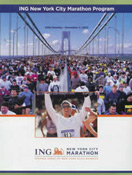News
 Months of physical training to prepare for the rigors of running 26.2 miles have made your body stronger and faster than ever. Mental training can bring your mind up to speed with your well-tuned body and turn a good ING New York City Marathon experience into a great one. Here are some psychological tools that you can use before and during your race to maximize performance and enjoyment.
Months of physical training to prepare for the rigors of running 26.2 miles have made your body stronger and faster than ever. Mental training can bring your mind up to speed with your well-tuned body and turn a good ING New York City Marathon experience into a great one. Here are some psychological tools that you can use before and during your race to maximize performance and enjoyment.
Pre-Race Strategies
Rational thinking. Pre-race thoughts are often filled with worry over things you can’t control. Try to recognize such irrational thinking patterns as “I didn’t train enough,” and “I must break four hours to be happy.” These thoughts are irrational because there is probably no evidence that they are true, and even if they are, there is nothing you can do about them in the days before the race. All they can do is eat away at your mental and physical energy. Replacing these thoughts with rational thinking can help your mind become clear and relaxed. Try to shift to thoughts such as “I would have preferred to train more, but I put in all the effort I could,” and “One of my goals is to break four hours, but I have other important goals as well.”
Thought watching. Sometimes thoughts erode our mental edge because we imbue them with negative energy. A better strategy is to view these thoughts objectively, as neither good not bad. Take a few minutes each day to allow worry thoughts, such as “It might be hot and I won’t finish,” to flash across your mind like words on a movie screen. Regard them with calm detachment, and you may be surprised by how clearheaded you feel. Thought watching is also a great method to use during your race.
Visualizing. Visualizing is a helpful technique because it increases the likely occurrence of -visualized behaviors. MRE studies have shown that visualizing an activity-such as running with good form-activates similar parts of the brain that are activated when performing the activity. Think of visualizing as priming your mind and body for success. For example, you can visualize running with restrained strength along Fourth Avenue in Brooklyn, steadily ascending the Queensboro Bridge, controlling your exuberance on First Avenue in Manhattan, and bearing down for the final tough miles in the Bronx, Harlem, and Central Park. To visualize successfully, sit in a comfortable chair, minimize distractions, and try to make your visions of success as vivid and detailed as possible. You’ll have a mental edge when they happen on race day.
Race-Day Strategies
Focus internally. One way to decrease race-day anxiety and maintain concentration is to focus inward. By concentrating on relaxing and maintaining good form-running tall, keeping a quick cadence, swinging your arms easily at your sides-you can simplify your thoughts, reduce distractions, and even feel sharper and faster.
Accept the challenge. When the going gets tough, recognize that the marathon is difficult and sometimes painful, and know that you have the ability to deal with the challenges. As you persevere through the tough miles, let yourself be surprised by feeling renewed strength after particularly hard patches.
Focus externally. Tuning in to cheering spectators and other runners can boost your mental energy and take the focus off your discomfort. Try some mental imagery, such as throwing an imaginary lasso around a runner 10 feet in front of you, tying the other end to your waist, and letting that runner pull you along.
Experienced runners use a variety of tools to gain the mental edge they need. Find what works best for you, and stay flexible in your approach, both in training and on marathon day. Good luck!


